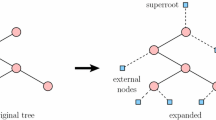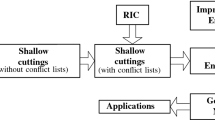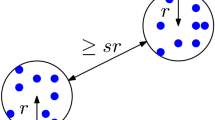Abstract
Given a set of n segments and a query shape Q, the windowing length query asks for finding the sum of the lengths of the parts of the segments that lie inside Q. The popular places problem of a set of curves asks for the subset of the plane where each query shape centered at a point of that region intersects with at least f distinct curves. For square queries, an optimal \(O(n^2)\) time algorithm and a matching lower bound exist. We solve the length query problem for convex polygons and disks as query shapes, with \(O(\log n+k)\) query time and polynomial preprocessing time that depends on the complexity of the query shape. We define a new version of the problem of finding popular places in a set of trajectories where the center of a query is a popular place if the length of the curves inside that query is at least f and use our data structure to solve the original problem as well as this new version. Other than length queries, we solve reporting queries that return the set of intersected segments. For disk queries, we design a point-location data structure for congruent disks with \(O(\log n)\) query time and \(O(n^3\log n)\) preprocessing. We also give algorithms for computing the length query for c-packed curves, which are a class of curves for which the length of the curve inside a disk of radius r is upper-bounded by cr, where c is a constant. Also, we use length queries for polygons to approximate the minimum value c for which a curve is c-packed, if such a c exists. Our results extend to MRC and MPC models for MapReduce, where we address these problems on a set of x-monotone curves. The round complexities of our MapReduce algorithms are constant. In addition, we also implemented our popular places algorithms on trajectories on inputs as big as 15K points to evaluate the efficiency of our algorithms in practice.


















Similar content being viewed by others
References
Agarwal PK, Har-Peled S, Varadarajan KR (2004) Approximating extent measures of points. J ACM 51(4):606–635
Arya S, Malamatos T, Mount DM (2007) A simple entropy-based algorithm for planar point location. ACM Trans Algorithms 3(2):17
Barequet G, Dickerson M, Pau P (1997) Translating a convex polygon to contain a maximum number of points. Comput Geom 8(4):167–179
Beame P, Koutris P, Suciu D (2013) Communication steps for parallel query processing. In: Proceedings of the 32nd ACM SIGMOD-SIGACT-SIGAI Symposium on Principles of Database Systems, ACM, pp 273–284
Benkert M, Djordjevic B, Gudmundsson J, Wolle T (2010) Finding popular places. Int J Comput Geom Appl 20(01):19–42
Benson RV (1966) Euclidean geometry and convexity. McGraw-Hill, New York
Bringmann K (2014) Why walking the dog takes time: Fréchet distance has no strongly subquadratic algorithms unless SETH fails. In: 2014 IEEE 55th Annual Symposium on Foundations of Computer Science, IEEE, pp 661–670
Chazelle BM, Lee DT (1986) On a circle placement problem. Computing 36(1–2):1–16
De Berg M, Van Kreveld M, Overmars M, Schwarzkopf O (1997) Computational geometry. Springer, Berlin, pp 1–17
Driemel A, Har-Peled S, Wenk C (2012) Approximating the Fréchet distance for realistic curves in near linear time. Discrete Comput Geom 48(1):94–127
Edelsbrunner H, Guibas LJ, Stolfi J (1986) Optimal point location in a monotone subdivision. SIAM J Comput 15(2):317–340
Edelsbrunner H, Guibas L, Pach J, Pollack R, Seidel R, Sharir M (1992) Arrangements of curves in the plane—topology, combinatorics, and algorithms. Theor Comput Sci 92(2):319–336
Fogel E, Halperin D, Wein R (2012) CGAL arrangements and their applications: a step-by-step guide, vol 7. Springer, Berlin
Fort M, Sellarès JA, Valladares N (2014) Computing and visualizing popular places. Knowl Inf Syst 40(2):411–437
Gilbert JR, Miller GL, Teng SH (1998) Geometric mesh partitioning: implementation and experiments. SIAM J Sci Comput 19(6):2091–2110
Goodrich MT (1991) Intersecting line segments in parallel with an output-sensitive number of processors. SIAM J Comput 20(4):737–755
Goodrich MT (1993) Constructing arrangements optimally in parallel. Discrete Comput Geom 9(4):371–385
Goodrich MT, Sitchinava N, Zhang Q (2011) Sorting, searching, and simulation in the MapReduce framework. arXiv:11011902
Haran I (2006) Efficient point location in general planar subdivisions using landmarks. Tel Aviv University, Tel Aviv
Karloff H, Suri S, Vassilvitskii S (2010) A model of computation for MapReduce. In: Proceedings of the Twenty-First Annual ACM-SIAM Symposium on Discrete Algorithms, SIAM, pp 938–948
Kaul A, Farouki RT (1995) Computing Minkowski sums of plane curves. Int J Comput Geom Appl 5(04):413–432
Kedem K, Livne R, Pach J, Sharir M (1986) On the union of Jordan regions and collision-free translational motion amidst polygonal obstacles. Discrete Comput Geom 1(1):59–71
Laube P, Imfeld S, Weibel R (2005) Discovering relative motion patterns in groups of moving point objects. Int J Geogr Inf Sci 19(6):639–668
Laube P, van Kreveld M, Imfeld S (2005) Finding REMO—detecting relative motion patterns in geospatial lifelines. Developments in spatial data handling. Springer, Berlin, pp 201–215
Leighton FT (2014) Introduction to parallel algorithms and architectures: arrays\(\cdot\) trees\(\cdot\) hypercubes. Elsevier, Amsterdam
Oks E, Sharir M (2006) Minkowski sums of monotone and general simple polygons. Discrete Comput Geom 35(2):223–240
Overmars MH, Yap CK (1991) New upper bounds in Klee’s measure problem. SIAM J Comput 20(6):1034–1045
Pollack R, Sharir M, Sifrony S (1988) Separating two simple polygons by a sequence of translations. Discrete Comput Geom 3(2):123–136
Sarnak N, Tarjan RE (1986) Planar point location using persistent search trees. Commun ACM 29(7):669–679
Shakhnarovich G, Darrell T, Indyk P (2006) Theory. The MIT Press, Cambridge
Sharir M (1987) Efficient algorithms for planning purely translational collision-free motion in two and three dimensions. In: Proceedings. 1987 IEEE International Conference on Robotics and Automation, Citeseer, vol 4, pp 1326–1331
Toth CD, O’Rourke J, Goodman JE (2017) Handbook of discrete and computational geometry (Chapter 28). Chapman and Hall/CRC, Boca Raton
Zheng K, Zheng Y, Yuan NJ, Shang S, Zhou X (2013) Online discovery of gathering patterns over trajectories. IEEE Trans Knowl Data Eng 26(8):1974–1988
Zheng Y, Li Q, Chen Y, Xie X, Ma WY (2008) Understanding mobility based on GPS data. In: Proceedings of the 10th International Conference on Ubiquitous Computing, pp 312–321
Zheng Y, Zhang L, Xie X, Ma WY (2009) Mining interesting locations and travel sequences from GPS trajectories. In: Proceedings of the 18th International Conference on World Wide Web, pp 791–800
Zheng Y, Xie X, Ma WY et al (2010) Geolife: a collaborative social networking service among user, location and trajectory. IEEE Data Eng Bull 33(2):32–39
Acknowledgements
The length query problem was an open problem in the Winter School on Computational Geometry 2014 at Amirkabir University of Technology.
Author information
Authors and Affiliations
Corresponding author
Additional information
Publisher's Note
Springer Nature remains neutral with regard to jurisdictional claims in published maps and institutional affiliations.
Rights and permissions
About this article
Cite this article
Aghamolaei, S., Keikha, V., Ghodsi, M. et al. Windowing queries using Minkowski sum and their extension to MapReduce. J Supercomput 77, 936–972 (2021). https://doi.org/10.1007/s11227-020-03299-7
Published:
Issue Date:
DOI: https://doi.org/10.1007/s11227-020-03299-7




